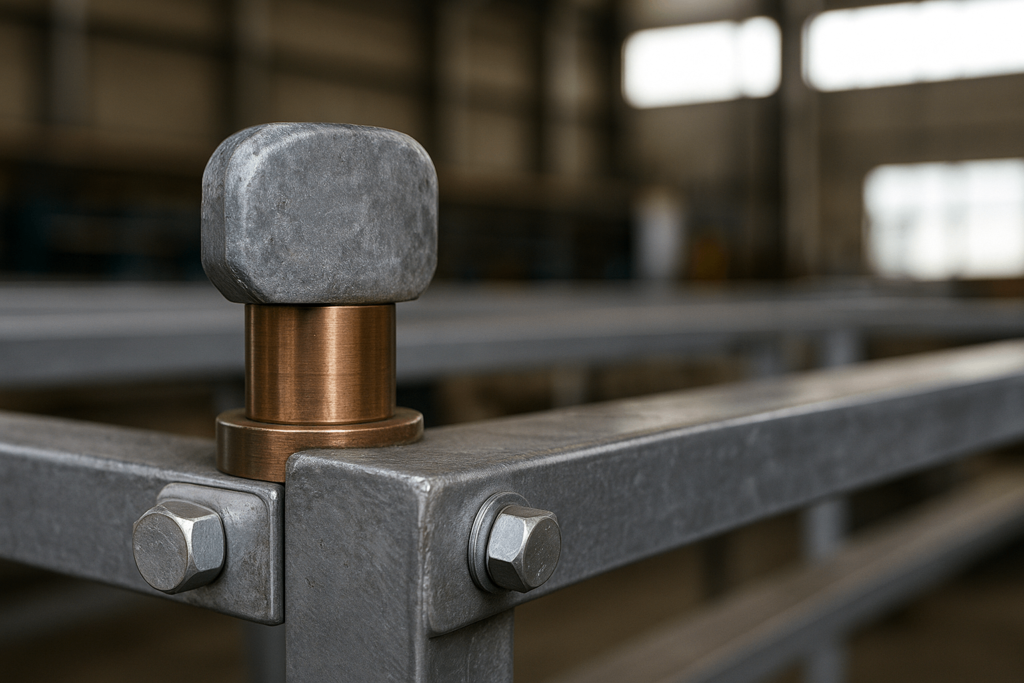In industrial material specification, precision in language is as critical as precision in fabrication. For high-stakes applications, understanding a material’s long-term behavior is a cornerstone of successful project outcomes and supply chain reliability. A frequent question arises: does lead rust?
The direct answer is no. This simple fact, however, opens the door to a more vital topic for engineers, designers, and procurement managers: the process of corrosion. While highly resistant to the red-brown decay specific to iron, lead is not immune to environmental degradation.
Understanding the nuances of lead’s interaction with its surroundings is key to harnessing its unique properties. This knowledge directly impacts the longevity, reliability, and total cost of ownership of your final product. This guide, drawing from YISHANG‘s 26+ years in custom metal fabrication, delves into the science of lead corrosion, its real-world implications, and the engineering strategies that ensure durable, high-performance components.
The Core Distinction: Why Lead Corrodes, Not Rusts
Grasping why lead doesn’t rust requires defining our terms. This distinction is not academic; it’s the foundation of material selection and a critical factor in your corrosion prevention strategy.
Understanding Rust: The Iron-Specific Phenomenon
Rust is the common term for one specific chemical reaction: the oxidation of iron and its alloys. When exposed to oxygen and moisture, iron forms hydrated iron oxides—a reddish-brown, flaky substance that is porous and brittle.
This process is inherently destructive. Rust flakes away, exposing fresh iron to continue a cycle of decay that compromises structural integrity. When we discuss “rusting,” we are scientifically referring to this self-perpetuating failure mode unique to iron-based metals.
Lead's Corrosion and the Formation of a Protective Patina
Lead undergoes a different process called corrosion, a broader term for chemical degradation. When exposed to the atmosphere, lead’s surface reacts with oxygen, but instead of a destructive oxide, it forms a thin, dense, and strongly adherent layer of lead oxide (PbO).
Over time, this layer reacts further with atmospheric carbon dioxide, creating a dull gray, stable, and non-porous layer known as a patina. This is a key lead corrosion product that, unlike iron rust, effectively seals the underlying metal from the environment, significantly slowing down further degradation. This self-passivating quality is why lead remains a critical material for applications demanding extreme durability.
A Visual Inspection Guide: Identifying Lead Corrosion in Industrial Components
For quality control managers and engineers, visually distinguishing between a protective patina and harmful corrosion is a critical skill for assessing component health. So, what does lead corrosion look like?
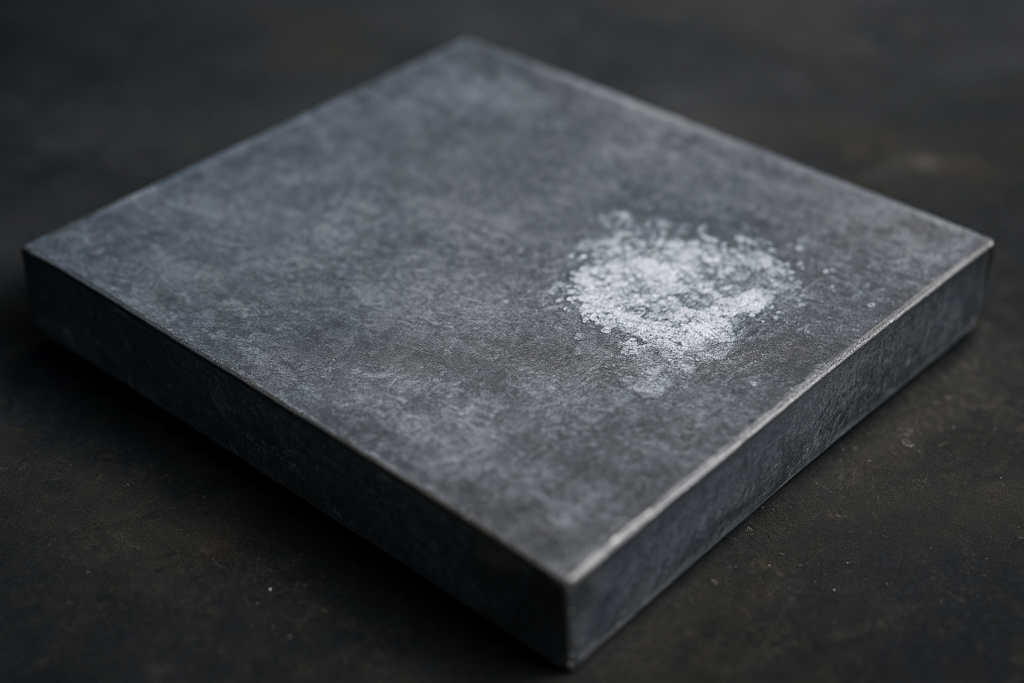
From Stable Patina to Active Corrosion
The most common visual cue is the dull, dark gray patina. This is typically uniform and smooth, indicating a stable, protective layer has formed—a sign of normal, healthy aging.
However, under specific chemical or moisture conditions, more active corrosion appears as a white, powdery substance. This is often lead carbonate or lead sulfate, signaling a more aggressive chemical attack. The specific lead corrosion color and texture are primary diagnostic tools during inspection.
Differentiating Benign Patina from Destructive Corrosion
The key difference lies in adherence. A benign patina is tightly bonded to the surface and cannot be easily rubbed off. It signifies successful passivation.
Destructive corrosion, the white powder, is typically looser and can be brushed away to reveal a pitted or altered surface. The presence of pitting or significant white deposits suggests the protective layer has been breached, a critical distinction when evaluating component integrity and making maintenance or replacement decisions.
Comparative Analysis: Visual Differences Between Lead Corrosion and Iron Rust
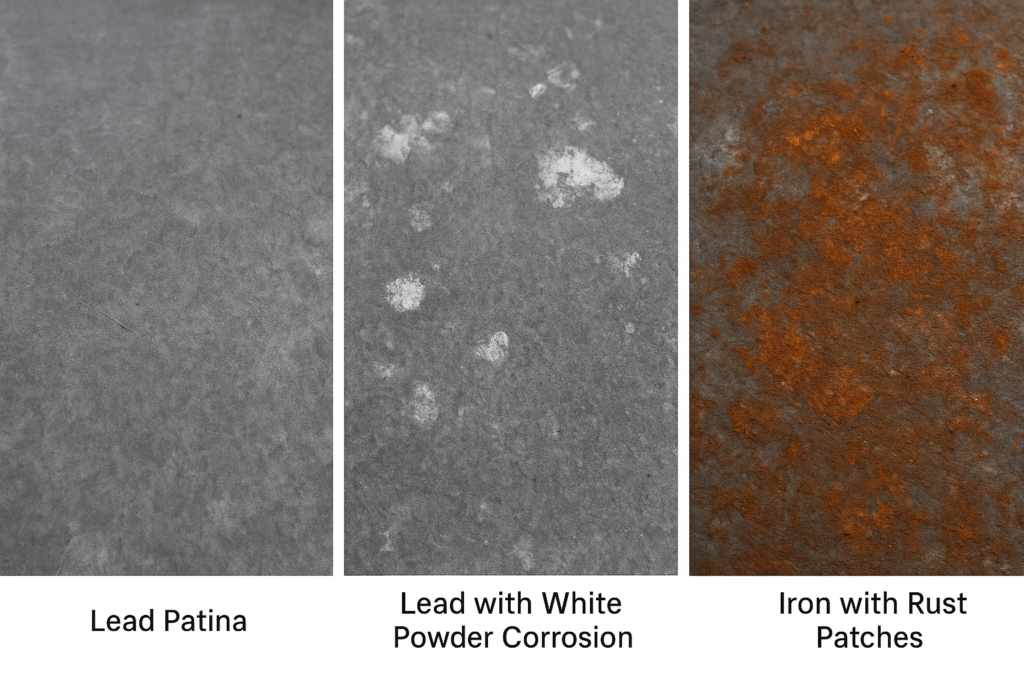
To aid in practical identification, this lead corrosion vs rust comparison is fundamental for any quality assurance process.
| Feature | Lead Corrosion (Typical Patina) | Active Lead Corrosion | Iron Rust (Ferric Oxide) |
|---|---|---|---|
| Color | Dull, dark gray to almost black. | White, chalky powder. | Reddish-brown, orange, sometimes yellow. |
| Texture | Smooth, hard, and non-porous. | Powdery, sometimes crystalline or crusty. | Flaky, rough, porous, and brittle. |
| Adherence | Tightly bonded to the metal surface. | Loosely adherent, can be brushed off. | Poorly adherent, flakes off easily. |
| Effect | Protective, self-limiting. | Indicates ongoing chemical attack. | Progressive and destructive. |
Understanding these cues ensures that the materials you procure meet the required specifications for longevity.
Environmental Triggers: Unpacking the Chemistry of Lead Degradation
The causes of lead corrosion are not intrinsic but result from a complex interplay with the environment. Understanding these triggers is fundamental to specifying the right material and design for durable products.
Atmospheric Factors: The Baseline for Passivation
The initial reaction with atmospheric oxygen, accelerated by humidity, and the subsequent reaction with carbon dioxide (CO₂) form the protective patina. In a typical, unpolluted environment, this slow process results in a highly durable shield, influencing the long-term lead corrosion rate.
Chemical Accelerants: Environmental Threats to Integrity
Lead’s resistance is most pronounced in neutral conditions. Its patina can be aggressively attacked by certain chemicals. Acidic conditions are particularly damaging, dissolving the protective layer and exposing fresh lead to rapid corrosion.
Sulfur compounds from polluted atmospheres and chloride ions from marine environments can also penetrate the passive layer, causing localized pitting. This is why your RFQ must detail the end-use chemical environment; it directly impacts the required material specification and potential need for protective coatings such as lead corrosion protection coatings or lead rust prevention for marine use.
Galvanic Corrosion: A Hidden Risk in Multi-Part Assemblies
A critical and often overlooked trigger is galvanic corrosion. This occurs when two different metals are in electrical contact in an electrolyte (like moisture), causing the more “active” metal to corrode at an accelerated rate.
In the galvanic series, which acts as a lead corrosion chart, lead is relatively noble. However, when it contacts more noble metals like copper or stainless steel, the lead will become the anode and corrode preferentially. This is a critical design consideration that must be addressed in any RFQ for multi-part assemblies to prevent premature failure and hidden warranty costs. As a custom fabricator, mitigating galvanic corrosion is a core part of YISHANG‘s engineering process.
The Real-World Impact: How Lead Corrosion Affects Performance and Procurement Decisions
The chemistry of corrosion becomes a tangible business risk when it impacts product performance. For B2B purchasers, understanding these sector-specific impacts is vital for making informed procurement decisions that go beyond initial price.
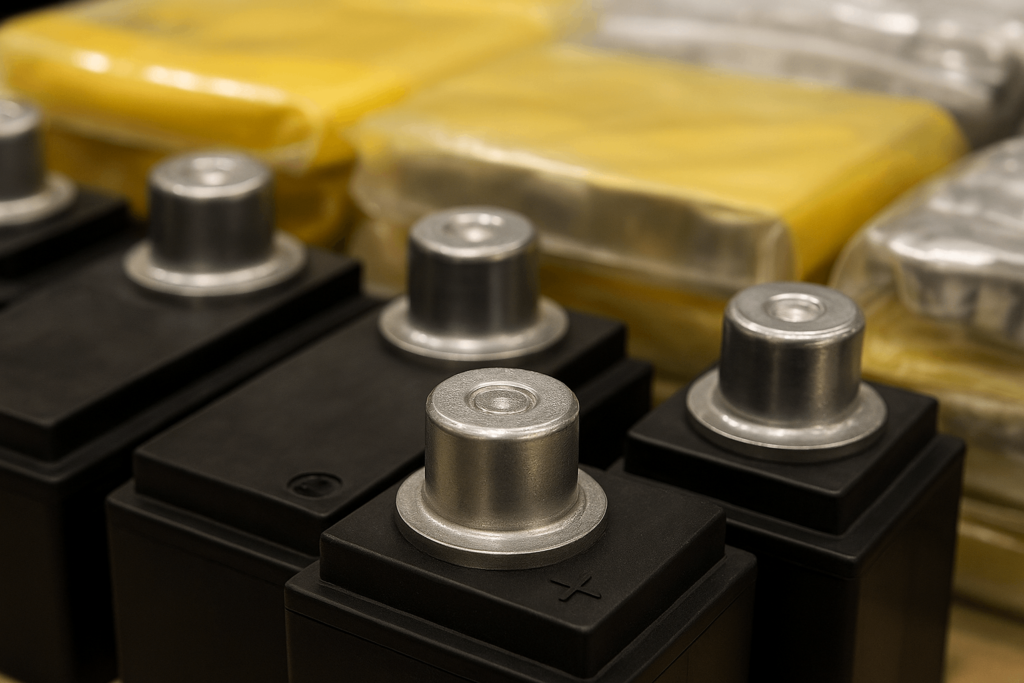
Construction & Architecture: Procurement for Longevity
In construction, lead is prized for roofing, with a potential lifespan of over 100 years according to the International Lead Association. However, sourcing lead for areas with high acid rain requires specifying a particular alloy or coating to ensure this longevity. Failure to do so can drastically shorten service life and increase the total cost of ownership.
Case Insight: In a 2023 project, YISHANG provided architectural-grade lead flashings for a government heritage restoration in Southeast Asia. The material passed 1,000 hours of neutral salt spray testing with no pitting, ensuring long-term aesthetic and structural performance.
Medical & Scientific: The Importance of Material Purity
Lead is the standard for radiation shielding. Here, corrosion that leads to pitting can create “thin spots,” compromising safety. The key procurement factor is not just the dimension, but the material’s purity and the supplier’s quality control. Sourcing from a proven partner like YISHANG, who understands the demands of medical-grade materials, mitigates these significant risks.
Energy Storage: Ensuring Product Reliability
In lead-acid batteries, a common failure mode is the corrosion of the lead terminals. For manufacturers, sourcing terminals with the correct alloy composition and protective coatings is essential for product reliability. The choice of supplier directly impacts end-product performance and warranty claims.
Case Insight: YISHANG recently developed custom-machined battery lead terminals for an energy storage OEM client in Germany. By applying a proprietary protective coating and testing under accelerated humidity conditions, the terminals demonstrated a 38% longer corrosion resistance compared to untreated equivalents.
Electronics & Automotive: Mitigating Risk with DFM
In these sectors, corrosion can lead to electrical or mechanical failure. Partnering with a manufacturer who provides Design for Manufacturing (DFM) feedback is invaluable. A proactive partner can identify potential corrosion risks early, preventing costly failures down the line.
Engineering for Longevity: Advanced Strategies for Preventing Lead Corrosion
Effective lead corrosion prevention is a proactive process. For an OEM & ODM partner, the focus is on engineering durable solutions from the outset, adding value that extends far beyond simple fabrication.
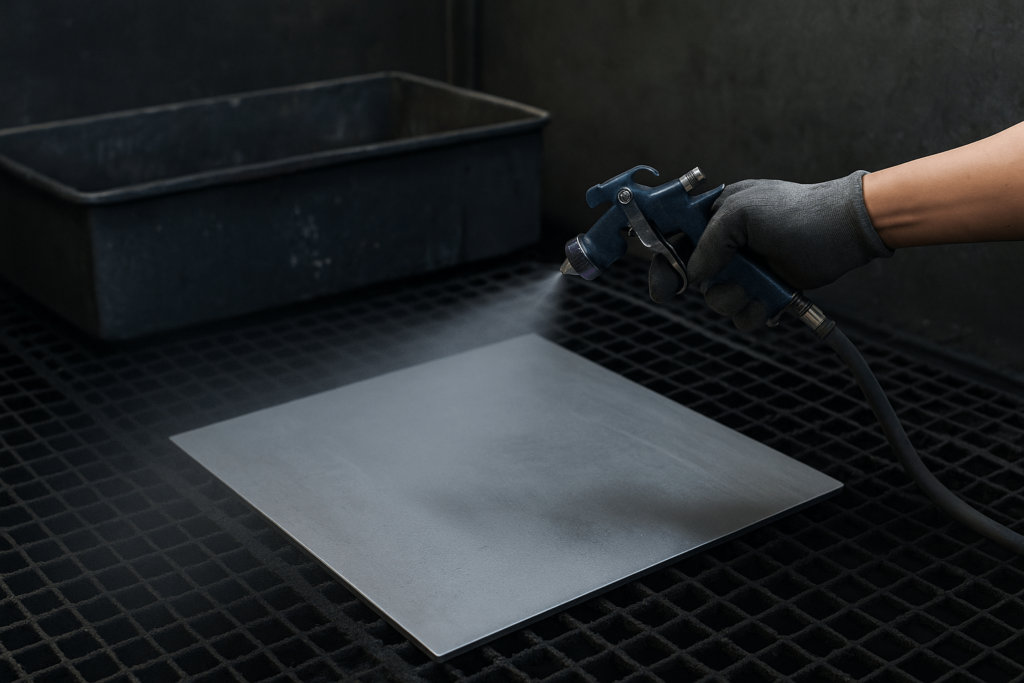
Material Selection and Alloying: Specifying for Performance
The first line of defense is material selection. While pure lead is common, alloying it with elements like antimony or tin can increase hardness and fatigue resistance—a key consideration for components under vibration. Selecting the correct alloy is a critical decision, and collaboration with an experienced fabricator like YISHANG ensures the material specification is optimized for both performance and cost.
Surface Treatment and Protective Coatings: A Barrier Against Aggression
For more aggressive environments, a range of surface treatments provides an additional layer of defense. These can include chemical passivation, polymer coatings, or powder coating. The right protective strategy, sometimes including a lead corrosion inhibitor for liquid environments or lead corrosion resistant coatings, ensures the component meets its expected service life, even in the harshest conditions.
Design for Prevention: Mitigating Risk in the OEM & ODM Process
The most effective corrosion prevention is often implemented at the design stage. Key considerations include eliminating crevices where water can collect and ensuring dissimilar metals are electrically isolated. This collaborative design process is a hallmark of a true manufacturing partner, turning a simple component order into a robust engineering solution.
Ensuring Quality and Compliance: The Role of Standards in Metal Fabrication
In the global B22B marketplace, trust is built on verifiable quality. Adherence to internationally recognized standards is a fundamental commitment to delivering reliable products.
Key Corrosion Testing Standards (e.g., ASTM B117)
To verify the effectiveness of protective coatings, manufacturers rely on standardized testing like ASTM B117 (salt spray test). Requesting data from such tests is a crucial part of supplier vetting, providing tangible evidence of the durability of the solution you are purchasing. This isn’t just a technical check; it’s a risk mitigation strategy.
The Importance of Quality Management Systems (ISO 9001)
Certification to ISO 9001 demonstrates a commitment to consistent processes and continuous improvement. For a client, our adherence to ISO 9001 is your assurance of supply chain reliability and consistent product quality, batch after batch. It minimizes risks and guarantees the final product meets your exact specifications.
Material Safety and Regulations (RoHS)
Compliance with material regulations like RoHS is critical. A knowledgeable manufacturing partner must be fully aware of these complex regulations, including any exemptions for lead. This expertise protects your business from regulatory issues and ensures the safety of the end-user.
Conclusion: Partnering for Durability and Precision in Your Next Project
So, does lead rust? No. Instead, it undergoes a managed corrosion process that, when understood, grants it renowned longevity. However, this durability is conditional upon its environment.
For industrial applications where performance is non-negotiable, ensuring product lifespan requires a holistic approach: intelligent design, appropriate material selection, and a rigorous commitment to quality. The difference between a component that lasts five years and one that lasts fifty often lies in the expertise of the manufacturing partner.
For complex projects requiring durable and precise components, collaborating with an experienced team is the key to success. To discuss the material specifications for your next project, contact the engineering team at YISHANG.

